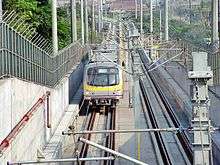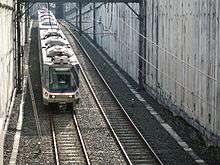Public transport in Metro Manila
Public transport in Metro Manila, Philippines is provided by light rail, rapid transit, commuter rail, bus, jeepney and taxicab. In 2015 e-hailing services Uber and Grab launched in Metro Manila to provide taxi-like services.
Rail services
As of 2008, there are two different rapid transit systems in Metro Manila: the Manila Light Rail Transit System, or the LRTA System, and the Manila Metro Rail Transit System, or the MRTC System. The Green Line (LRT-1) and the Blue Line (LRT-2) form the LRTA network, while the Yellow Line (MRT-3) forms the MRTC network, with 29 stations on the LRTA and 13 stations on the MRTC . Four more lines are proposed and would connect Metro Manila to the provinces of Bulacan, Cavite, Laguna and Rizal upon their completion.
| Current line name | New line name |
|---|---|
| Manila LRT Line 1 (LRT-1) | Green Line |
| Manila LRT Line 2 (LRT-2) | Blue Line |
| Manila MRT Line 3 (MRT-3) | Yellow Line |
| PNR Southrail | Orange Line |
LRTA system


- see main article: Manila Light Rail Transit System (LRT-1 and LRT-2)
Manila Light Rail Transit System Line 1 (Green Line/LRT-1)
Manila Light Rail Transit System Line 2 (Blue Line/LRT-2)
Manila Light Rail Transit System has two lines, the Green Line that runs along the length of Taft Avenue (R-2) and Rizal Avenue (R-9), and the Blue Line that runs along Ramon Magsaysay Blvd (R-6) from Santa Cruz, through Quezon City, up to Santolan in Marikina and Pasig.
MRTC system

- see main article: Manila Metro Rail Transit System (Yellow Line/MRT-3)
The Manila Metro Rail Transit System has a single line, MRT-3 or the Yellow Line.
Commuter rail
Philippine National Railways (PNR) operates a commuter line that serves a region from Metro Manila south toward Laguna. PNR, a state-owned railway system of the Philippines, was established during the Spanish Colonial period. It used to provide services on Luzon, connecting northern and southern Luzon with Manila. In 1988 the railway line to northern Luzon (Northrail) became disused although plans to revive the northern line (Northrail) have been proposed. Services on the southern line (Southrail) continued throughout the 90s, but were halted as a consequence of damages caused by typhoons Milenyo and Reming. After a short revival, services to Bicol from Manila were halted again in 2012. The national government plans to reopen the line to Bicol in the future.
The Philippine National Railways Commuter service, Metro South Commuter, run daily between Tutuban and Alabang.[1] There are plans to extend this service further south to Calamba with the rehabilitation of the rail line.
Bus
Manila has many metrobus companies such as Erjohn & Almark, Baclaran Metro Link and AC Trans. These use Japanese buses (especially Isuzu or Nissan Diesel) converted to Left-hand drive. As such, the rear and emergency doors are swapped.
Jeepney

- see main article: Jeepney
Manila's local style of [shared taxi].
